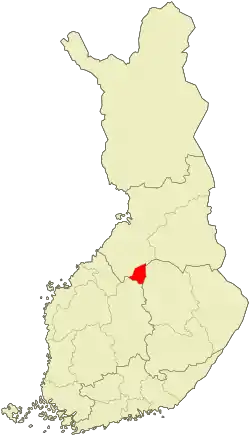Pyhäjärvi
Pyhäjärvi (1993–1995 Pyhäsalmi) is a town and municipality in the south of Northern Ostrobothnia region, Finland. Pyhäjärvi also borders the Northern Savonia and Central Finland regions. The town belongs to the subregion of Nivala–Haapajärvi. Its seat is in Pyhäsalmi.
Pyhäjärvi | |
|---|---|
Town | |
| Pyhäjärven kaupunki Pyhäjärvi stad | |
 Coat of arms | |
 Location of Pyhäjärvi in Finland | |
| Coordinates: 63°41′N 025°59′E | |
| Country | |
| Region | Northern Ostrobothnia |
| Sub-region | Nivala–Haapajärvi sub-region |
| Charter | 1866 |
| Town privileges | 1993 |
| Seat | Pyhäsalmi |
| Government | |
| • Town manager | Henrik Kiviniemi |
| Area (2018-01-01)[1] | |
| • Total | 1,459.46 km2 (563.50 sq mi) |
| • Land | 1,311.06 km2 (506.20 sq mi) |
| • Water | 148.42 km2 (57.31 sq mi) |
| Area rank | 53rd largest in Finland |
| Population (2020-07-31)[2] | |
| • Total | 5,088 |
| • Rank | 169th largest in Finland |
| • Density | 3.88/km2 (10.0/sq mi) |
| Population by native language | |
| • Finnish | 99.2% (official) |
| • Swedish | 0.2% |
| • Others | 0.6% |
| Population by age | |
| • 0 to 14 | 15% |
| • 15 to 64 | 60.7% |
| • 65 or older | 24.3% |
| Time zone | UTC+02:00 (EET) |
| • Summer (DST) | UTC+03:00 (EEST) |
| Municipal tax rate[5] | 19.75% |
| Website | www.pyhajarvi.fi |
Neighbouring municipalities are Haapajärvi, Kiuruvesi, Kärsämäki, Pielavesi, Pihtipudas and Pyhäntä.
As the highway 4 (E75), the highway 27 and the Ylivieska–Iisalmi railway all run through the town, Pyhäjärvi is well situated in an intersection of communication and transport services. The town has also an airfield.[6]
The town of Pyhäjärvi, was founded in 1866, and it was then named after Lake Pyhäjärvi, a lake of 125 square kilometres (48 sq mi) and rich in fish. Pyhäjärvi became officially a town in January 1993. The town has 5,088 inhabitants (31 July 2020),[2] of whom some 60 percent live in the two population centres Pyhäsalmi and Ruotanen.
Pyhäjärvi contains Europe's deepest base metal mine, the 1,444 metres (4,738 ft) deep Pyhäsalmi Mine from where zinc and copper is mined. Underground mining was due to end in 2019, but has been granted approximately 14 months more of mining activity due to an increase in demand for pyrite from Yara in Siilinjärvi.[7] The on-surface refinery will be operational until 2025.[8] The mine facilities and the associated infrastructure will be used for underground business and research under the Callio Pyhäsalmi project.[8][9]
References
- "Area of Finnish Municipalities 1.1.2018" (PDF). National Land Survey of Finland. Retrieved 30 January 2018.
- "Suomen virallinen tilasto (SVT): Väestön ennakkotilasto [verkkojulkaisu]. Heinäkuu 2020" (in Finnish). Statistics Finland. Retrieved 13 September 2020.
- "Population according to language and the number of foreigners and land area km2 by area as of 31 December 2008". Statistics Finland's PX-Web databases. Statistics Finland. Retrieved 29 March 2009.
- "Population according to age and gender by area as of 31 December 2008". Statistics Finland's PX-Web databases. Statistics Finland. Retrieved 28 April 2009.
- "List of municipal and parish tax rates in 2011". Tax Administration of Finland. 29 November 2010. Retrieved 13 March 2011.
- "EFPY Pyhäsalmi, Finland". VFR Suomi / Finland. Finavia. 12 February 2009. Archived from the original on 16 October 2007. Retrieved 13 March 2009.
- "Pyhäsalmen kaivos sai yli vuoden jatkoajan lannoitetehtaan ansiosta". Yle Uutiset (in Finnish). Retrieved 2020-01-12.
- Jokinen, Juha Veli (January 29, 2018). "Euroopan syvin kaivos lopettaa Pyhäsalmella - tilalle sirkkoja, salaattiviljelyä ja energiavarasto" (in Finnish). Retrieved 2018-03-04.
- "First Quantum Minerals Ltd. - Our Business - Operating Mines - Pyhäsalmi". www.first-quantum.com. Retrieved 2018-03-04.
External links
| Wikivoyage has a travel guide for Pyhäjärvi. |
 Media related to Pyhäjärvi (municipality) at Wikimedia Commons
Media related to Pyhäjärvi (municipality) at Wikimedia Commons- Town of Pyhäjärvi – Official website
